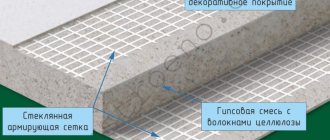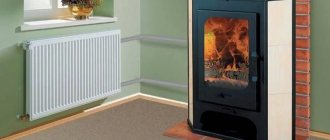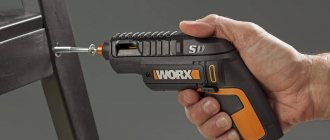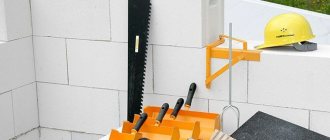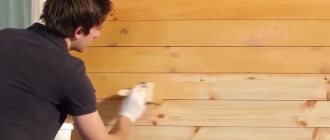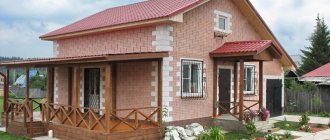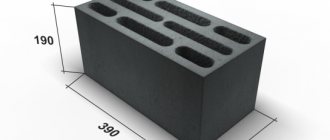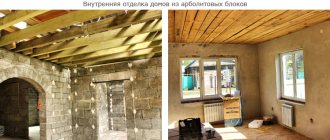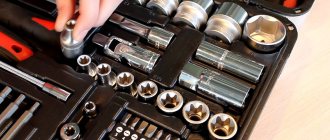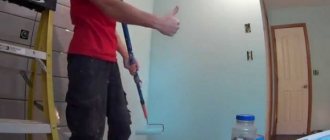Aerated concrete, being a modern and technologically advanced material with its own set of physical and chemical properties, requires high precision in laying and cutting. For this purpose, a whole class of tools has been developed, which will be discussed in this publication. We will talk about how to cut aerated concrete blocks and how to do it correctly.
Hand saw
This saw is used in the construction of small objects (country house, outbuilding, garage, etc.), where it is not necessary to saw a large number of foam blocks.
However, it is worth thinking about what to cut; if the density of the foam blocks is high, then it is better, of course, to use an electric tool.
Don’t be afraid of a hand saw; if you work carefully and carefully, you can cut without unevenness or chips, and you can also cut out shaped elements.
However, you need to remember that foam blocks are a special building material; you need to work with it carefully. When sawing, it tends to crumble! No need to put pressure on the tool! Only completely dry material can be cut with a hand saw.
Sawing, as a rule, is better and easier according to pre-made marks. The position of the saw should be at an angle of 45 degrees. The saw must be long so that at the finish line the unfinished residue does not break off and fall off, ruining the cut.
Tape
The devices are designed for cutting various materials using a closed belt made of metals using high-frequency alloys. The band saw for aerated concrete has the advantage of height adjustment and good performance. Cutting of aerated concrete blocks is carried out using a tape; this technique allows you to make longitudinal and shaped cuts.
Chainsaws are used to create U-blocks from standard products. According to reviews from builders, it is recommended to clean chain saws from oils and lubricant mixtures. Because they cause dust from aerated concrete to stick to the mechanism, which provokes accelerated wear of the moving elements.
A frequently asked question is: is it possible to cut aerated concrete with a chainsaw? According to reviews from craftsmen, a strong abrasive occurs during work, and the tool quickly becomes dirty and fails. Therefore, it is better to use an electric saw for aerated concrete, where a filter is put on the side of the brushes.
Electric jigsaw
Craftsmen know this type of jigsaw as a reciprocating saw. This saw is used in the construction of medium and large objects.
You can change the blades on a jigsaw (put discs with different tooth sizes, change dull or damaged discs; the shape of the teeth on the discs can also be different - large and small teeth).
As a rule, for the convenience of builders, many saw models are available with replaceable batteries so as not to be tied to a power source.
When working with this type of tool, you must remember that sawing wet material is not permissible, as this may result in injury. The saw will “chew” the crumbs and may injure the builder.
Before starting work, it is better to try on the tool. Play through the saw movements without the power on.
You need to cut with the middle part of the saw; the length of the working cutting surface should be approximately 25 centimeters.
To avoid injury, you should hold the saw firmly in your hands.
How to properly use a saw to cut gas blocks
Working with any of the listed tools requires certain skills. For example, cutting with a hand hacksaw is best done using a pre-prepared miter box or corner. Using such an assistant will reduce the likelihood that the canvas will “wiggle” to the sides.
Practice shows that working with a hacksaw with a soft, bendable bar without guides guarantees “movement” to the side by 5 or more centimeters.
Purchasing a reciprocating saw does not guarantee that the subsequent cut will be flawless. The danger lies in the possibility of the knife “jamming” and breaking. This can be avoided by making rhythmic, forward movements that repeat the movement of the cutting element. Such actions make it easier to remove dust from the seam, which causes damage. Working with an “Alligator” or an electric chain saw is considered the easiest and fastest of all the options for so-called “mobile” sawing. Even a person who does not have any skills can cope with them. The only thing he must take into account is the need for regular and thorough cleaning of the mechanisms. Otherwise, they quickly become unusable.
Alligator
The alligator-type saw is particularly durable and wear-resistant. The teeth of such a saw have special coatings made of pobedite, which makes the teeth more durable. This tool is used in the construction of large objects (apartment buildings, large offices).
The advantage of this tool is that it does not need to be constantly sharpened or blades changed, as, for example, in an electric jigsaw.
When purchasing such a saw, it is better to choose an option with a thick-walled blade, since only cutting with such a blade will give an even cut without chips or roughness.
It is often written that before starting to work with such a saw, you need to lubricate the surface with a special lubricant, but practice says otherwise. The lubricant mixes with dust, causing the saw to stop working.
Although the instructions for most tools of this type specify the use of lubricant. The absence of lubricant increases productivity significantly.
Hand hacksaws with carbide tips.
It took a while to find a good hand saw for aerated concrete either. First, we purchased different hacksaws from the construction market. All of them had pobedit solderings located through the tooth. These hacksaws cut poorly. The cutting was distracting, the sawing process itself was tiring. Once in St. Petersburg, in a construction hypermarket, I came across a hacksaw with brazing points on every tooth. But the expectations were not met - the sawing process became easier, but the cut still turned out uneven.
Separately, it should be noted devices for simplifying the cutting of blocks - squares for cutting aerated concrete.
As they taught in geometry lessons at school, a plane is formed by two intersecting lines. These products are designed according to this principle. By installing this device on the edge of the block, the other two guides seem to form a perpendicular plane to the upper edge of the block. And if you guide the hacksaw blade, pressing it against both guides at once, you should get an even cut.
It seems that everything is simple - put a mark with the required size, place this square on it - and just saw off. For some reason, however, this does not give a stable result. And the reason is not only that these devices give a small error - try drawing lines along this square with a pencil, and then, turning the block over, apply the square to the drawn line, drawing on the next edge. You will not come to the starting point. But the problem is also how to press the saw blade to the guides.
And then the insight came - and the carbide brazings also do not form an ideal row - some of them are knocked out to the right and left. These “upstarts” push the fabric away from the guides, filling the seam up a little with a “screw”. For the same reason, any imperfect hacksaw produces a cut using a screw. The protruding tooth “leads” the end of the saw to the side with each movement, twisting the cut.
In general, even with a good hacksaw it’s difficult to cut the block straight without turning it over. In the process, we developed our own technology for smooth cutting. Using a tape measure, mark the cutting line on three faces of the block (see video in this article). By analogy with a square, the cut is not made progressively, but as if rotating around a point on one face, lowering the other end of the saw along a mark on a perpendicular face. This results in a diagonal cut. Then the block is rotated around its axis by 90 degrees and the operation is repeated, only the cut is lowered along the mark on the third face. As a result, if the markings are applied accurately, in half the cases there is a slight error, and in the other half the cut is perfect. But - if the saw was appropriate.
The first corresponding saw was purchased in 2013 in Estonia. Manufacturer – Bahco
It would seem, what’s wrong with it? I can list them on my fingers – soldering on each tooth, ideal geometry of soldering, small width of soldering, arrangement of soldering in a straight line, without “upstarts”, even elastic blade of the hacksaw. Subjectively, this saw was a revelation. First of all, I was pleased with the easy movement of the saw. Even high-density aerated concrete was easy to saw, only the number of movements increased. These saws are still in use today. The weak point was the wooden handle. One day a saw was forgotten at a construction site. It rained at night, and under the scorching sun the next day the handle cracked. This model is currently out of production. But if you search on the Internet, you might get lucky.
Also, large manufacturers of aerated concrete, for example, Ytong, ordered such saws from Bahco with their logo. Hurry - there are still some on sale.
Bahco is currently releasing another model, a modernized one. The soldered blade remained the same; a Teflon coating of the blade and a composite handle were added. It is somewhat similar to the Kalashnikov assault rifle - its modernization took place according to a similar scenario. But for some reason, a stripped-down model of this saw is supplied to Russia - with 17 tips on 34 teeth.
Why is that? Because products are supplied to Russia from factories for third world countries. For “whites”, welcome to the European Union - this saw is normal there. Compared to the previous model, the price has increased by 30 percent. There is modernization and inflation here, and with the rather high euro exchange rate, the price in rubles will not seem cheap.
True, the price does not stop our colleagues - by the season they start calling: “Are you going to Estonia?” Sometimes they order it again - jamshuds “kill” even such a saw during the season - they cut brick, concrete, they test the fittings “to the teeth”.
Household saw on chain
Some home craftsmen saw foam blocks with a regular saw, which is used to saw wood. This method is fast and quite effective, but the chains quickly become dull, and sometimes even break and jam.
In addition, when cutting with such a saw, a very large amount of harmful dust is generated. Therefore, if you plan to saw in this way, be sure to protect your respiratory organs from dust.
When choosing a tool for cutting aerated concrete, there is no need to chase cheapness. As a rule, cheap does not mean reliable. However, it is better not to rely on your intuition, especially if you have no experience in this matter, but to read reviews or talk with knowledgeable people.
Usually people without experience who want to build a small object for themselves opt for hand tools. Firstly, it is cheaper, and secondly, it is easier to work with. People with experience prefer a more complex tool - an electric one.
Grinder and electric wall chaser
There are special attachments for the grinder, which are two metal disks that leave behind two even grooves.
There are also specialized grinders, the so-called electric wall chasers, in which you can adjust the width and depth of the groove. After cutting, the aerated concrete itself must be selected using a chisel and hammer. Among the advantages, we note the high speed and evenness of the cut, and among the disadvantages, there is a large amount of dust, which will require connecting a vacuum cleaner.
Foam blocks: how and how to cut products made of cellular concrete
Reciprocating saw for cutting cellular materials
The active use of cellular concrete in construction raises quite a lot of questions for those who have chosen them for building a house. Porous products are easy to process; they are simply sawed with hand or mechanical tools. If foam blocks are chosen as a building material, you need to know what and how to cut in more detail.
Manufacturers
Choosing the optimal tool for your construction site is not difficult. Construction stores offer a wide selection of accessories for sawing aerated concrete, both manually and mechanized.
Hand saws
A hand saw for aerated concrete differs from a carpenter’s saw in several ways:
- Increased length of the blade, allowing you to make transverse and longitudinal cuts.
- Increased thickness of steel used to make the blade. This reduces the likelihood of deformations and avoids distortion of cuts.
- The presence of additional soldering on the teeth (every other). The cutting edge is large, which ensures a long service life. On expensive models there are rapid tips with pobedit tips with the addition of cobalt, monocarbide or tungsten. The service life of such tools is designed to process 20-30 m³ of gas block.
Ytong
It is a subsidiary of Xella, which produces aerated concrete blocks, reinforced lintels, prefabricated monolithic structures and other products. Ytong produces and sells through distributors professional tools for working with cellular concrete.
Hacksaw characteristics:
- Handle material: wood.
- Gross weight: 1.5 kg.
- Blade material: steel.
- Length: 816 mm.
- Price: 2,500 – 2,800 rub.
Anchor
The largest instrumental company. It operates through its own representative offices throughout the Russian Federation. The price list includes several thousand product items, from pipes and fittings to small road equipment and woodworking machines.
Technical characteristics of the hacksaw Enkor Raven 9847:
- Blade material: steel.
- Handle material: two-component.
- Gross weight: 900 g.
- Blade length: 670 mm.
- Price: 1,230 – 1,250 rub.
Reciprocating saws
The saw received its frightening name due to its appearance, similar to this type of weapon. Of the many brands, we note a few:
Bosch
A German brand with production plants in many countries around the world.
| Model | Power, W | Idle speed | price, rub. |
| PSA 700 E | 710 | 2 700 | 6 039 |
| GSA 1 100 E | 1 100 | 0-2 700 | 10 987 |
| GSA 1,300 PCE | 1 300 | 0-2 900 | 14 098 |
| GSA 18 V-Li C (battery) | 18 V | 0-2 700 | 24 899 |
| GSA 18V | 18 B | 0-2 700 | 46 370 |
Makita
The Japanese brand is one of the leaders in the production of construction tools. The concern has 8 enterprises, 2 of which are located in Europe: Great Britain and Germany.
| Model | Power/battery capacity | Net weight, g. | price, rub. |
| JR102DZ (without battery and charger) | 10.8V | 1 100 | 4 459 |
| 10.8V | 1 300 | 6 390 | |
| SD100DZ (without battery and charger) | 10.8 V | 1 400 | 11 129 |
| JR3070CT | 1 510W | 4 300 | 14 709 |
| DJR186RFE 187266 (battery) | 18V | 3 500 | 23 969 |
Stayer
Supplier of professional hand tools for a wide range of purposes. Sells products under its own brand. It does not have a line of reciprocating saws. The Stayer company offers a wide selection of blades for electric saws for aerated concrete.
Band saws
Used for cutting large volumes of gas blocks. Provides high precision and the most even surface. Has high performance.
Lissmac
A German company engaged in the production of construction equipment and machinery. The most popular are the 3 models of machines presented in the table.
| Model/Characteristics | MBS 510 | MBS 650 | MBS 760 |
| Cutting height, mm. | 510 | 650 | 760 |
| Cut length, mm. | 700 | 700 | 700 |
| Length of the tape, mm. | 3 750 | 4 020 | 4 566 |
| Engine power, kW/,V | 1,1/ 400 1,5/ 230 | 1,1/ 400 1,5/ 230 | 1,1/ 400 |
| Crossbar diameter, mm. | 490 | 490 | 535 |
| Dimensions (length, width, height), mm. | 1 080/ 750 / 1 840 | 1 080/ 750/ 1 975 | 1 560/ 985/ 2 215 |
| Weight, kg. | 173 | 175 | 367 |
At first glance, it may seem that the structure of aerated concrete is soft and porous. Your opinion about him will change after you start working with him. It’s one thing to cut 2-3 blocks, another thing is to cut 40-50 m³ of concrete for a full-fledged house.
How to cut cellular concrete
When calculating foam blocks for your home, you can try to select their size so as to lay the products without cutting. But this method is very labor-intensive, and most likely it will hardly succeed.
Another option would be to vary the thickness of the vertical seams. But this is also not so easy to do. The large width of the gaps between the blocks can seriously deteriorate the thermal characteristics of the masonry.
In addition, it is impossible to do without the use of non-standard sized elements when making door and window openings or some complex architectural forms of a building.
This material is very easy to process: it can be sawed at any angle and given a variety of shapes. Therefore, it will be easier to figure out how and with what to cut foam blocks.
For this work you can use hand or mechanical tools:
- Wood saw;
- Hand saw for sawing cellular materials;
- Grinder (angle grinder) with diamond discs;
- Rope equipment;
- Reciprocating type electric saw;
- Band saw for blocks.
Advice: do not use electric chain saws. They give a large cutting width, an uneven cut and wear out quickly.
Laser equipment is also used for cutting concrete.
Hand tool
How can you cut foam blocks?
The easiest and cheapest way is to use hand tools. But it is only suitable for small amounts of work.
It is quite easy to manually cut elements to fit door and window openings and create wall corners. Cutting foam blocks with hand tools is characterized by maneuverability and ease of execution.
For greater accuracy when working with hand tools you will also need:
- Regular ruler;
- Pencil or marker;
- Corner made of metal or lath.
Cutting blocks with hand tools
How to cut a foam block manually?
The following tools are suitable for this:
- A wood hacksaw will help if several blocks require cutting. For large volumes of work, the tool will need to be sharpened frequently, which is quite labor-intensive. In addition, it is difficult to work with such a device.
- A special hand saw for cutting porous materials differs from a regular hacksaw in that the metal is thicker - due to this, it bends less. The saw also has a special coating or soldering of hard alloy on large teeth. Tools are produced with one or two handles. The canvas is made in various lengths.
A more effective option would be to use a power tool.
Additional accessories for cutting aerated concrete
All of the tools listed above are universal. To carry out certain specific work, additional devices are used:
- Planer for aerated concrete - is a grater with a metal sole and a comfortable handle. Designed for precise adjustment of block sizes and alignment of cut points after sawing.
- A manual wall chaser is a specially bent metal pipe with a handle that allows you to quickly scratch rounded depressions on the surface of the material into which reinforcement and communication rods are placed (after the construction of the house).
- Electric wall chaser. Outwardly it resembles a circular saw, but has two cutting disks rotating in parallel. Due to the built-in mechanism for adjusting the cutting depth, it is able to produce ideal slots for grooves of the required depth. As an inexpensive replacement, you can use a classic grinder with an appropriate disc.
- Crowns - you can take standard ones for concrete, with pobedite soldering. They are used to create blind and through round holes in walls for ventilation, socket boxes, and so on.
- Do-it-yourself corner for cutting aerated concrete - used to control the progress of the cut.
From all the listed diversity it is clear that a good master must have a tool for every working occasion.
How to cut cellular blocks
If you have to work with hand tools, then the question of how to cut foam blocks can be solved quite simply:
- The foam block is laid on a flat horizontal surface.
- Mark the cutting areas.
- The block is placed on supports - other blocks can be used.
- Holding the element with your hand, saw off the required part with smooth movements.
Cutting foam block with a string:
- The rope is thrown onto the block.
- The cable is fixed in a special machine.
- The equipment sets the string into action - the element is sawed.
Technologically, this is a rather complex sawing method.
Features of concrete saws
Cutting saws for reciprocating saws for concrete are diamond-coated blades that provide deep cuts from 30 to 40 centimeters. Choosing the right concrete diamond saw blade is essential to performing the cutting. For example, some concrete structures have steel rods (reinforced concrete) and pebbles or crushed stone, while others do not.
Saw blades for concrete are marked with the parameters of the blade. Reciprocating saw blades for concrete must be marked HM, CV. Blades made of particularly hard alloys are used for concrete work and are installed on saws with a power of 1 kW or more. To quickly cut concrete structures, you need a powerful tool. It is worth noting that saws designed for working with abrasive materials are also well suited for cutting concrete.
It is not enough to choose the optimal blade - it is important to remember the specifics of working with this tool. Before use, the support shoe is adjusted. It is important to achieve the shortest length of the canvas that extends beyond the boundaries of the surface to be finished. This will protect the blade teeth from wear. It is forbidden to make blind cuts at the risk of destroying the gear units of the saw.
Other tools for working with foam blocks
How to cut a foam block so that each element has a perfectly smooth surface?
To do this, you need one more tool - a plane for cellular concrete. Small metal files with fine teeth are attached to a wooden block at an angle. With this device it is easy to level the surfaces of the cut block.
Planer for leveling the surface of cellular blocks
The use of a plane allows you to reduce the consumption of glue for laying foam blocks.
A wall chaser for foam blocks is a manual device for making grooves on the surface of elements. Channels are necessary for laying fittings, electrical wiring or utilities. The wall chaser has a simple design: a double-sided cutter made of hard alloy and a hand holder.
Instructions for working with the wall chaser:
- Markings are applied to the block along the channel placement line.
- The tool cutter is installed on the surface of the element.
- By smoothly pressing the handle, the device is moved along the intended line.
For greater accuracy and convenience when working with a wall chaser, you can put a rail on it.
The operating principle of an electric wall chaser is identical to a manual one. But they make cuts on concrete easier and faster. The electric wall chaser has several cutting surfaces. Special rollers move the tool around the block without any extra effort.
When choosing how to cut foam blocks, you should take into account the nuances of the structure of lightweight concrete, as well as the features of the equipment for working with them. An important component will be the economic feasibility of using a particular tool.
In many cases, the availability of electricity and water at the place of work plays a role. Complex equipment requires appropriately qualified workers.
You will receive more information on the topic: “How and with what can you cut foam blocks?” by watching the video in this article.
What you need to know about cutting foam concrete?
A guarantee that the cutting of foam concrete will be of high quality is not only the correct selection of cutting tools, but also well-made markings on the block itself. In addition, you just need to be able to use the tool you are using and, of course, do not forget about safety precautions, especially if you are using an automated saw.
To do this, each device, as a rule, has instructions with a photo, which shows the main components and the correct position of the tool when used.
Note! Stability, quality and accuracy of cutting are ensured by strong fastening of the foam block and the correct direction of the cutting part of the tool. The saw blade must be directed perpendicular to the plane of its surface into which it cuts, and in accordance with the markings. For accurate and precise cutting, a special tool is used - a corner for foam blocks.
The video in this article shows how to properly hold the tool and the foam block itself when cutting it.
What and how to cut aerated concrete
Aerated concrete blocks are often used in individual construction due to qualities such as good thermal resistance, low weight and ease of machining.
The main benefits of working with this building material are ease of processing and laying due to its light weight and large size. Aerated concrete is easy to drill, saw, chop, plane, groove and shape into complex geometric shapes with hand tools, such as an aerated concrete saw, plane or chisel.
Features of the material
Aerated concrete is a lightweight building material that can be cut with your own hands.
Aerated concrete is made from a mixture of Portland cement and sand, into which reagents are poured to form foam. Most often, ordinary powdered aluminum, aluminum pastes and powders are used for this. As a result of their reaction with Portland cement, small air bubbles are evenly distributed throughout the structure of the solution.
Depending on the density, aerated concrete blocks are divided into brands:
- D300-D500 – heat-insulating building material.
- D500-D900 – structural and thermal insulation material.
- D1000–D1200 – structural blocks.
The compressive strength of aerated concrete is 1.5 - 3.5 kgf/cm². In a dry state, the thermal conductivity of aerated concrete is 0.12 W/m°C. The density of this material is 400 - 1200 kg/m³.
Enclosing and load-bearing structures built from aerated concrete belong to fire safety classes I and II.
This material is environmentally friendly, since no toxic substances are released from it during operation.
Due to its good performance characteristics, aerated concrete is widely used in low-rise construction.
Basics of processing aerated concrete blocks with saws
Craftsmen who have more experience with construction electrical equipment and fixtures, as well as the need to work with them more often, prefer to cut aerated concrete bricks with an electric reciprocating saw or alligator saw rather than with hand tools. But with a one-time use of aerated concrete (for example, when constructing an outbuilding, garage or country house - you don’t need several of them on one site), a hand saw for aerated concrete will be more economical and reliable.
- An electric reciprocating saw for aerated concrete is a powerful jigsaw that imparts a horizontal reciprocating motion to the saber-shaped cutting blade. There are saws with two blades, and many models are battery-powered. Reciprocating saw blades are sold with teeth of different sizes and shapes.
- The alligator saw works on the principle of a crankshaft - the rotation of the electric motor rotor turns into reciprocating movements of two cutting blades. The blades move in opposite directions, but in a horizontal plane, so the cutting edge is always clean and even. The price of such a power tool is much higher than that of a reciprocating saw, and an alligator saw will pay off only with constant use, that is, in professional construction. Therefore, before such a highly specialized purchase, think about where this tool will work after construction is completed.
- A hand saw with carbide (pobedite) tipped teeth lasts much longer than a regular hand saw, which has to be sharpened after several cuts. You can build a house using pobedit tips without replacing the saw, and it will still serve you in the future. When choosing such a tool, it is recommended to pay attention to the thickness of the blade - a thin saw will be pulled to the side, the cut will be uneven and inclined. A saw with a thick blade makes precise, neat and even cuts.
Therefore, when choosing what to cut aerated concrete with, pay attention to the accuracy and reliability of the tool, and not to its price: many people think that an expensive power tool is the key to successful construction, but this is not always the case. First try cutting the foam block with a regular hand saw, and only if the results are unsatisfactory, buy more expensive saws for aerated concrete.
When might cutting or sawing be required?
Concrete blocks come in standard sizes and the building materials market rarely focuses on selling anything non-standard.
During the construction process, the master understands that he needs to find a block that could complete the masonry in a certain place, and standard material will not work here. In such a situation, you have to resort to cutting the block concrete material.
If concrete blocks of non-standard size are needed in large quantities, then it is better to cast them yourself using homemade molds. You can also order non-standard blocks from the manufacturer, but this will cost more.
Often, a builder may need half or a quarter of a whole concrete block. Then you need to make a cut.
Similar situations often occur when pouring a strip foundation, when all the blocks must be the same size, and when completing its arrangement, several elements are missing. The same situation can arise when constructing a building according to an established design, when the thickness of the walls is already clearly defined and it is impossible to deviate from the values.
Often, when laying corners, it is not possible to fit the concrete block correctly and gaps remain between the stones. Many builders fill them with fragments of material, which is also not entirely true. In this case, it is recommended to pay attention to the tools and methods by which you can quickly and easily cut concrete block material.
Sawing by hand
A common but incorrect idea is that sawing aerated concrete by hand is a long and thankless task, with poor results (uneven cuts, torn edges, tedious and unproductive). But for an individual developer, it is possible and necessary to cut the blocks manually, since with a fairly thick canvas, the cut will always be smooth, and the porosity of the material does not put much strain on the hands. It's all about the cutting technique, the material and brand of foam block. If you are going to use a hand saw to cut a gas block or foam concrete brick of class B 2.0 and density (grade) D 400, then you will like the result. But the class B 3.5 block of the D 600 brand will make you think about purchasing an electric cutting tool.
A correctly chosen hand saw allows you to make several thousand cuts, and these can be complex lines in the form of a trapezoid or hemisphere. The conclusion suggests itself: in addition to the foam block brand, it is important to develop the correct process technique:
- Do not press too hard on the saw so that the blade does not move to the sides. Aerated concrete needs to be cut differently from boards or slats - the material is not cut, but crumbles, so pressure is not needed here in principle.
- Before sawing aerated concrete blocks, make sure they are well dried - wet crumbs will get stuck in the cut and complicate the cutting process.
- An even cut will be achieved if the block is first marked on three sides. Shallow cuts of 20–30 mm are made on the markings.
- The blade must follow the cuts so that there are no deviations along the planes. The saw should be held at an angle of 45° and not put pressure on the blade. To prevent the sawn piece from falling at the end of sawing and breaking off with uneven edges, the block must lie with its entire body on the stand.
- The hacksaw should be long so that the blade completely and with a margin covers the length of the brick.
- To make the work easier, you can make a tul from boards or plywood.
How to cut a block with electric tools
Sawing gas or foam concrete with electric saws speeds up the process and increases the volume of work, and also allows you to cut out architectural elements with complex configurations. The method is justified when constructing large objects or houses of two or three floors. The optimal choice for such work would be an alligator saw or an electric reciprocating saw for aerated concrete with a power of approximately 1000 W and a blade length of 365 mm.
Important: When sawing with an electric saw of any type, you must take only dry foam blocks, otherwise the saw may bite in the cut and be torn out of your hands.
Working with a reciprocating saw:
- Before cutting, it is recommended to practice the movements with the tool turned off: the saw blade should not be placed firmly against the block. Before cutting, you need to hold the tool at some distance from the cut, while rocking the saw up, down and back in the center, as if it were a handsaw. It is necessary to cut the block not with the entire blade, but with its central part; the length of the cutting surface should be approximately 250 mm.
- When working with a reciprocating saw, pressing it against the end of the product, you can get dust sticking and biting the blade, especially on a raw block. Therefore, it is recommended to make cuts from both sides towards each other.
- “Alligator” is a professional tool, and working with it will only pay off on large volumes. However, no one will cut a large number of gas blocks with a hand saw, since this is a rather slow process, and if there is a lot of material, it can be tedious. Sawing with an alligator saw speeds up the work.
- Experience working with this power tool has shown that it is not necessary to lubricate the sawing surfaces, as stated in the instructions, since hard dust will immediately stick to the lubricant, which simply throws out the lubricant, after which the saw works on dry material and the blade often jams. If the lubricant was factory-made, it must be removed immediately, but to do this you will have to disassemble the saw. This unusual approach with correction of the factory instructions allows you to dissolve 50–70 blocks up to 1 meter long in 2–3 hours, with a cutting length of 500–600 mm. If the product is long, the cut is made on both sides, with preliminary marking of the sides.
How to choose the right chains for a power saw
Sawing aerated concrete with a regular wood chain is not allowed. Practice shows that a new chain, regardless of the brand, is enough for no more than 5-10 D500 blocks. It makes more sense to use for this special carbide with reinforced pobeditovy tips, designed specifically for these purposes.
Examples of prices for Stihl chains for aerated concrete:
| Chain number | Step | Thickness, mm. | Number of links | price, rub. |
| 36120030068 | 3/8 | 1,3 | 68 | 2 720 |
| 36120030091 | 3/8 | 1,3 | 91 | 3 640 |
| 36120030108 | 3/8 | 1,3 | 108 | 4 320 |
| 36120030144 | 3/8 | 1,3 | 144 | 5 760 |
| 36120030189 | 3/8 | 1,3 | 189 | 7 560 |
Expert opinion Vitaly Kudryashov builder, aspiring author
Ask a Question
All of the options presented are great for cutting aerated concrete and can stay sharp longer than regular saw chains.
